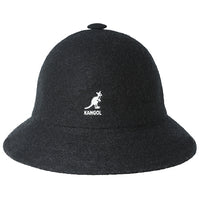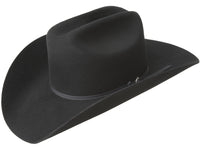Hat Styles
Part of a Hat Diagram
 There are two main parts to hat: the crown and the brim.
There are two main parts to hat: the crown and the brim.
The crown is the part that fits over your head. Crowns come in various heights, depending on style. The brim is the edge of the hat that the crown is attached to. At the bottom of the crown is typically a band that secures the hat on your head.
The crown can be pushed in at several different places for variation. Depressions on the sides of the crown are called indentations, and the depression on the top of the crown is called a crease. The crease can reverse itself so its center points upward, instead of into the hat. Indentations and creases vary in depth. In fact, some hats donít have a crease in the crown -- these hats may be rounded or flat on top.
The brim can vary in width from narrow to wide. A snapped brim is one with edges bent to point down or up. The most common snapped hats are pointed downwards in the front and upwards in the back. The brim can be rolled, so that the very edge of the brim is rounded up and towards the crown. Additionally, hat edges can be folded so that they stand at a right angle to the brim.
A band occupies the space where the brim meets the crown. It can be in different colors and widths. Hats can be worn tilted, to the sides, back, or front, or a combination of several angles.
These variables account for the vast majority of mensí hat styles.
Hat Styles
Click the hats below to learn more about each individual style. To understand the history behind these famous hat styles, visit our Hat Style Timeline.

BowlerThe Bowler is a hard, felt hat popularized in 19th century England as the hat of choice for the working class. It was the bowler, not the cowboy hat, that can first claim the title of “hat that won the West.” Most Americans that headed westward after the Civil War wore it. It was the “go-to” hat for men west of the Mississippi until at least the turn of the 20th century. The Bowler is hard enough to grant a fair amount of protection to its wearer. It has a medium-sized crown, rounded at the top. The brim is narrow and rolled all the way around. The band is often the same color as hat, which is traditionally black. |
Ivy CapAlso known as the flat cap or cab driver’s cap, the ivy cap dates definitely to 16th century England. In an effort to spur domestic wool production, Parliament decreed that all men, with the exception of nobility, had to wear a wool cap. The bill only lasted 20 years, but the ivy cap had already solidified its status as a middle and lower class staple. Though it was also worn by the upper class in less urban environments, it was considered a staple for the working class in 19th century England. It was Irish immigrants, especially, who brought the hat to America. Currently, ivy caps are popular with certain groups, like some punk cultures, hip-hop artists, and older men of certain nationalities. Most recently, the 2008 US Olympic team wore white flat caps designed by Ralph Lauren. The ivy cap is a close-fitting cap with a stiff brim in the front. The cap material doubles over on top of the brim. The top forms almost a right angle with the back. It’s traditionally made from wool or tweed. |
FedoraLike many other mens’ hats, the fedora was most popular in earlier years: specifically, the first half of the 20th century. It was a special hallmark of actors and singers in the 1940s and 1950s. However, it has resurfaced in the past decade or two, probably thanks to Indiana Jones. The fedora is a soft felt hat with a medium-size crown, with both indents and a crease. The extent of the indents and creases vary with model. The brim is medium-width, and is usually either snapped down in the front and up at the back, or completely flat. |
BoaterThe boater, a somewhat formal hat, has always been summer attire. It reached its peak of popularity around the turn of the 20th century, when it was worn by sailors and boaters. Today, its use is mostly limited to nautical or sailing contexts, like rowing. The boater is a straw hat with short crown, flat on top without creases or indents. It’s very round, with a medium-width flat brim. It often features a thick band in a bright color. |
TrilbyThe trilby is a style of fedora. The name was coined after a stage adaption of the novel Trilby, performed right at the turn of the 20th century, in which a female character wore the hat. It was once an informal hat for the upper class, but became widespread in the 1950s and 1960s, as wearing other, higher-crowned hats was no longer practical in cars. The trilby is usually made of felt and features a low crown and a narrow brim. It’s always snapped down in the front while the back is either snapped up or folded up at a right angle. Like the fedora, it has indentations and creases; typically the crease is very strong. The band can be a contrasting or similar color. |
CowboyThe cowboy hat followed the bowler as the typical hat of the Western man. The cowboy hat as we know it wasn’t invented until 1865, by John Batterson Stetson. The first model was called “The Boss of the Plains,” and it was a high-crowned, wide-brimmed hat without any indents or creases in the crown. The spread of the cowboy hat relies as much on popular culture and Eastern perceptions of the West as it does the actual hat-wearing habits of cowboys. However, that’s not to discount the usefulness and eventual dominance of the cowboy hat among ranchers. The felt was waterproof and the shape of the crease and indents could be adjusted for the climate, to either hold air in or dispel it. It became a symbol of rodeo clowns, some police units, Western entertainers like Buffalo Bill, and characters in Western movies. It was a hat designed for use in the West, and eventually became synonymous with it. There are many variations on the cowboy hat, most of them adjusting either the indent and crease pattern, or the brim roll or snap. All of them, however, share at least two characteristics: a high crown and a wide brim. When wet, felt can be adjusted, and will stay in the shape that it dries in, so many different styles of cowboy hat crowns emerged. Many were particular to certain ranges or ranches. Cowboy brims range from flat brims, to edges that are completely rolled over, to sides folded at a right angle. They usually feature a slight snapping down in front and up in back. Cowboy bands are often decorative and made of leather or ribbon. |
Top HatThe top hat was once linked directly to the upper class. Now, it’s worn mostly to events that require white tie or morning dress, the latter of which has almost disappeared in the United States. It’s a stiff hat made of silk, with a tall, flat crown. Some hats are tapered inversely, so the top of their crown is slightly broader than the crown at the brim. The brim is medium width and rolled all the way around. They can be white, gray, or black, with a band color that matches. |
PorkpieThe Porkpie originated in the mid-19th century as ladies’ hat, but would later become popular with a variety of groups in the next 100 years. It was worn by British male socialites, American Civil War soldiers, jazz musicians, and the Jamaican predecessors to skinheads. The porkpie, made from felt or straw, is notable for its short crown with a small-to-medium brim. There are no indentations, but typically a circular crease on the top. The crease is usually reversed, so that the crown appears at the top. The brim is usually flat or slightly rolled all the way around. |
HomburgThe Homburg is a less formal alternative to the top hat. It was made fashionable by Edward VII in the late 19th century and remained popular among the upper class in Britain for half a century. Its most recent attention came when Al Pacino wore one in the Godfather movies. The Homburg features a medium crown with a crease in the top but usually no indentation. The medium brim is rolled all the way around, with the sides slightly snapped up. The Homburg’s band is usually the same color as the hat. |
AscotThe ascot is a hat that is similar to the ivy cap but features a hard and round shape whereas the ivy is distinguished by its soft form. Also known as Cuffley caps, ascots are typically made of wool felt and worn in the cooler months. Ascots are most commonly seen in solid colors, however tweed and patchwork styles are becoming more popular. |
PanamaThe Panama hat is named after the Isthmus of Panama, where gold miners from California, and later Teddy Roosevelt, discovered the hats and adopted them. However, they originated in Ecuador, and were merely shipped to the rest of the world from Panama. They reached their popularity in the 19th century among South Americans, but later became known as the go-to vacation hat for American men. They were much cooler than felt hats and could be folded without damage. The hats receded in popularity, like most hats, in the second half of the 20th century. The Panama is like the straw version of the fedora. It has a medium height crown and medium width brim. The crown usually has a crease on the top and may have indentations. The brim can be fairly flat or slightly snapped at the front. The band is typically black. |
NewsboyThe newsboy developed in England during the turn of the 20th century. It’s similar to the flat cap but bigger. It’s typically divided into eight panels, joined by a button at the top. The front brim can usually be snapped to the doubled-over cap in the front. |



















































